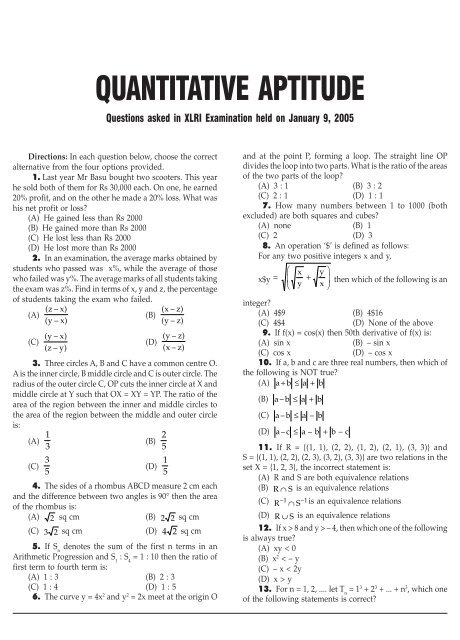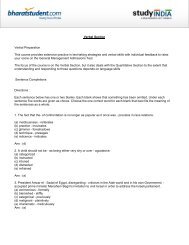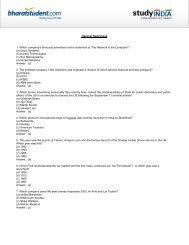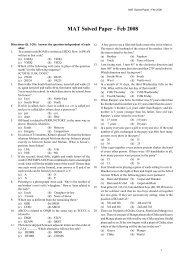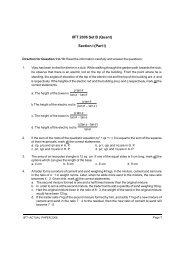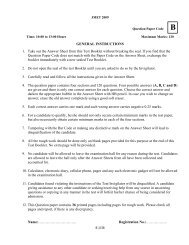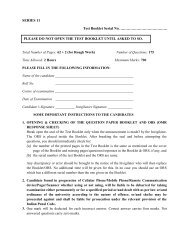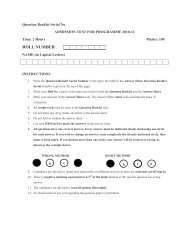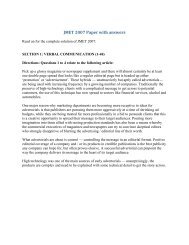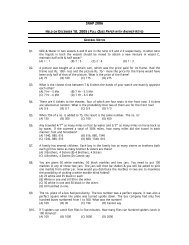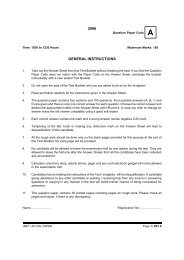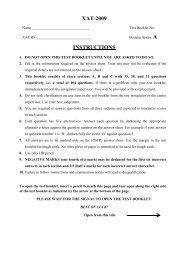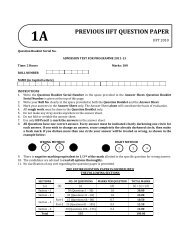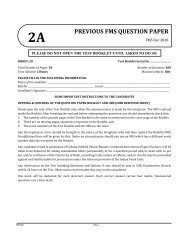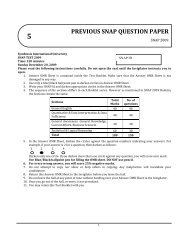QUANTITATIVE APTITUDE
QUANTITATIVE APTITUDE
QUANTITATIVE APTITUDE
Create successful ePaper yourself
Turn your PDF publications into a flip-book with our unique Google optimized e-Paper software.
<strong>QUANTITATIVE</strong> <strong>APTITUDE</strong><br />
Directions: In each question below, choose the correct<br />
alternative from the four options provided.<br />
1. Last year Mr Basu bought two scooters. This year<br />
he sold both of them for Rs 30,000 each. On one, he earned<br />
20% profit, and on the other he made a 20% loss. What was<br />
his net profit or loss?<br />
(A) He gained less than Rs 2000<br />
(B) He gained more than Rs 2000<br />
(C) He lost less than Rs 2000<br />
(D) He lost more than Rs 2000<br />
2. In an examination, the average marks obtained by<br />
students who passed was x%, while the average of those<br />
who failed was y%. The average marks of all students taking<br />
the exam was z%. Find in terms of x, y and z, the percentage<br />
of students taking the exam who failed.<br />
( z– x)<br />
( x– z)<br />
(A)<br />
(B)<br />
( y– x)<br />
( y– z)<br />
(C)<br />
( y– x)<br />
( z– y)<br />
(D)<br />
( y– z)<br />
( x– z)<br />
3. Three circles A, B and C have a common centre O.<br />
A is the inner circle, B middle circle and C is outer circle. The<br />
radius of the outer circle C, OP cuts the inner circle at X and<br />
middle circle at Y such that OX = XY = YP. The ratio of the<br />
area of the region between the inner and middle circles to<br />
the area of the region between the middle and outer circle<br />
is:<br />
(A) 1<br />
3<br />
(C) 3<br />
5<br />
Questions asked in XLRI Examination held on January 9, 2005<br />
(B) 2<br />
5<br />
(D) 1<br />
5<br />
4. The sides of a rhombus ABCD measure 2 cm each<br />
and the difference between two angles is 90° then the area<br />
of the rhombus is:<br />
(A) 2 sq cm (B) 2 2 sq cm<br />
(C) 3 2 sq cm (D) 4 2 sq cm<br />
5. If S n denotes the sum of the first n terms in an<br />
Arithmetic Progression and S 1 : S 4 = 1 : 10 then the ratio of<br />
first term to fourth term is:<br />
(A) 1 : 3 (B) 2 : 3<br />
(C) 1 : 4 (D) 1 : 5<br />
6. The curve y = 4x 2 and y 2 = 2x meet at the origin O<br />
and at the point P, forming a loop. The straight line OP<br />
divides the loop into two parts. What is the ratio of the areas<br />
of the two parts of the loop?<br />
(A) 3 : 1 (B) 3 : 2<br />
(C) 2 : 1 (D) 1 : 1<br />
7. How many numbers between 1 to 1000 (both<br />
excluded) are both squares and cubes?<br />
(A) none (B) 1<br />
(C) 2 (D) 3<br />
8. An operation ‘$’ is defined as follows:<br />
For any two positive integers x and y,<br />
F x yI<br />
x$y = +<br />
y x<br />
then which of the following is an<br />
HG<br />
KJ<br />
integer?<br />
(A) 4$9 (B) 4$16<br />
(C) 4$4 (D) None of the above<br />
9. If f(x) = cos(x) then 50th derivative of f(x) is:<br />
(A) sin x (B) – sin x<br />
(C) cos x (D) – cos x<br />
10. If a, b and c are three real numbers, then which of<br />
the following is NOT true?<br />
(A) a+ b ≤ a + b<br />
(B) a– b ≤ a + b<br />
(C) a– b ≤ a – b<br />
(D) a– c ≤ a – b + b − c<br />
11. If R = {(1, 1), (2, 2), (1, 2), (2, 1), (3, 3)} and<br />
S = {(1, 1), (2, 2), (2, 3), (3, 2), (3, 3)} are two relations in the<br />
set X = {1, 2, 3}, the incorrect statement is:<br />
(A) R and S are both equivalence relations<br />
(B) R∩ S is an equivalence relations<br />
(C) −1 −<br />
R ∩ S<br />
1is an equivalence relations<br />
(D) R S<br />
∪ is an equivalence relations<br />
12. If x > 8 and y > – 4, then which one of the following<br />
is always true?<br />
(A) xy < 0<br />
(B) x 2 < – y<br />
(C) – x < 2y<br />
(D) x > y<br />
13. For n = 1, 2, .... let T n = 1 3 + 2 3 + ... + n 3 , which one<br />
of the following statements is correct?
(A) There is no value of n for which T is a positive<br />
n<br />
power of 2.<br />
(B) There is exactly one value of n for which T is a n<br />
positive power of 2.<br />
(C) There are exactly two values of n for which T is n<br />
a positive power of 2.<br />
(D) There are more than two values of n for which Tn is a positive power of 2.<br />
14. An equilateral triangle is formed by joining the<br />
middle points of the sides of a given equilateral triangle. A<br />
third equilateral triangle is formed inside the second<br />
equilateral triangle in the same way. If the process continues<br />
indefinitely, then the sum of areas of all such triangles when<br />
the side of the first triangle is 16 cm is:<br />
(A) 256 3 sq cm<br />
(B) 256<br />
3 sq cm<br />
3<br />
(C) 64<br />
3 sq cm<br />
3<br />
(D) 64 3 sq cm<br />
15. The length of the sides of a triangle are x + 1,<br />
9 – x and 5x – 3. The number of values of x for which the<br />
triangle is isosceles is:<br />
(A) 0 (B) 1<br />
(C) 2 (D) 3<br />
2 2 2<br />
x – 2x+<br />
a + b<br />
16. The expression 2 2 2 lies between:<br />
x + 2x+<br />
a + b<br />
(A)<br />
2 2<br />
a + b + 1<br />
and<br />
a<br />
2<br />
+ b<br />
2<br />
– 1<br />
(B) a and b<br />
a2 + b2<br />
+ 1<br />
(C)<br />
and 1<br />
2 2<br />
a + b – 1<br />
(D)<br />
a2 + b2<br />
−1<br />
2 2<br />
a + b + 1<br />
2 2<br />
a + b −1<br />
a<br />
2<br />
+ b<br />
2<br />
+ 1<br />
17. What is the sum of first 100 terms which are<br />
common to both the progressions<br />
17, 21, 25, ... and 16, 21, 26, .... :<br />
(A) 100000 (B) 101100<br />
(C) 111000 (D) 100110<br />
18. Two people agree to meet on January 9, 2005<br />
between 6.00 P.M. to 7.00 P.M., with the understanding that<br />
each will wait no longer than 20 minutes for the other. What<br />
is the probability that they will meet?<br />
(A) 5<br />
(B)<br />
9<br />
7<br />
9<br />
(C) 2<br />
9<br />
(D) 4<br />
9<br />
OBJECTIVE-TYPE QUESTIONS<br />
x+ a x b<br />
19. If the roots of the equation<br />
x+ a+ c x b c<br />
+<br />
+<br />
= 1<br />
+ +<br />
are equal in magnitude but opposite in sign, then:<br />
(A) c≥ a<br />
(B) a≥c (C) a + b = 0 (D) a = b<br />
20. Steel Express runs between Tatanagar and Howrah<br />
and has five stoppages in between. Find the number of<br />
different kinds of one-way second class ticket that Indian<br />
Railways will have to print to service all types of passengers<br />
who might travel by Steel Express?<br />
(A) 49 (B) 42<br />
(C) 21 (D) 7<br />
21. The horizontal distance of a kite from the boy flying<br />
it is 30 m and 50 m of cord is out from the roll. If the wind<br />
moves the kite horizontally at the rate of 5 km per hour<br />
directly away from the boy, how fast is the cord being<br />
released?<br />
(A) 3 km per hour<br />
(B) 4 km per hour<br />
(C) 5 km per hour<br />
(D) 6 km per hour<br />
22. Suppose S and T are sets of vectors, where<br />
S = {(1,0,0), (0, 0, –5), (0, 3, 4)} and T = {(5, 2, 3), (5, –3, 4)}<br />
then:<br />
(A) S and T both sets are linearly independent vectors<br />
(B) S is a set of linearly independent vector, but T is not<br />
(C) T is a set of linearly independent vectors, but S is<br />
not<br />
(D) Neither S nor T is a set of linearly indepedent<br />
vectors<br />
23. Suppose the function ‘f’ satisfies the equation<br />
f (x + y) = f(x) f(y) x and y. f(x) = 1 + xg(x) where<br />
lim g(x) = T, where T is a positive integer. If f<br />
x→0<br />
n (x) = kf(x)<br />
then k is equal to:<br />
(A) T (B) Tn (C) log T (D) (log T) n<br />
24. Set of real numbers ‘x, y’, satisfying, inequations<br />
x – 3y ≥ 0, x + y ≥ –2 and 3x – y≤ – 2 is:<br />
(A) Empty (B) Finite<br />
(C) Infinite (D) Cannot be determined<br />
25. ABCD is a trapezium, such that AB, DC are parallel<br />
and BC is perpendicular to them. If °<br />
∠ DAB = 45 , BC = 2 cm<br />
and CD = 3 cm then AB = ?<br />
(A) 5 cm (B) 4 cm<br />
(C) 3 cm (D) 2 cm<br />
26. If F is a differentiable function such that F(3) = 6<br />
and F(9) = 2, then there must exist at least one number ‘a’<br />
between 3 and 9, such that:<br />
(A) F’(a) = 3<br />
2<br />
(C) F’(a) = – 3<br />
2<br />
A<br />
(B) F(a) = – 3<br />
2<br />
(D) F’(a) = – 2<br />
3<br />
27. A conical tent of given capacity has to be
constructed. The ratio of the height to the radius of the base<br />
for the minimum amount of canvas required for the tent is:<br />
(A) 1 : 2 (B) 2 : 1 (C) 1: 2 (D) 2 : 1<br />
28. If n is a positive integer, let S(n) denote the sum of<br />
the positive divisors of n, including n and G(n) is the greatest<br />
divisor of n. If H(n) = Gn ( )<br />
then which of the following is<br />
Sn ( )<br />
the largest?<br />
(A) H(2009) (B) H(2010)<br />
(C) H(2011) (D) H(2012)<br />
29. If the ratio of the roots of the equation<br />
x2 – 2ax + b = 0<br />
is equal to that of the roots<br />
x2 – 2cx + d = 0, then:<br />
(A) a2b = c2d (B) a2c = b2d (C) a2d = c2b (D) d2b = c2a 30. X and Y are two variable quantities. The<br />
corresponding values of X and Y are given below:<br />
X : 3 6 9 12 24<br />
Y : 24 12 8 6 3<br />
Then the relationship between X and Y is given by:<br />
(A) X+ Y∝ X– Y<br />
(B) X Y + ∝<br />
X Y<br />
1<br />
–<br />
(C) X∝Y (D) x∝ Y<br />
1<br />
Read the following and answer questions 31 to 34<br />
based on the same.<br />
Eight sets A, B, C, D, E, F, G and H are such that<br />
A is a superset of B, but subset of C.<br />
B is a subset of D, but superset of E.<br />
F is a subset of A, but superset of B.<br />
G is a superset of D, but subset of F.<br />
H is a subset of B.<br />
N(A), N(B), N(C), N(D), N(E), N(F), N(G) and N(H) are<br />
the number of elements in the sets A, B, C, D, E, F, G and H<br />
respectively.<br />
31. Which one of the following could be FALSE, but<br />
not necessarily FALSE?<br />
(A) E is a subset of D<br />
(B) E is a subset of C<br />
(C) E is a subset of A<br />
(D) E is a subset of H<br />
32. If P is a new set and P is a superset of A and N(P)<br />
is the number of elements in P, then which of the following<br />
must be true?<br />
(A) N(G) is smaller than only four numbers<br />
(B) N(C) is the greatest<br />
(C) N(B) is the smallest<br />
(D) N(P) is the greatest<br />
33. If Q and Z are two new sets superset of H and<br />
N(Q) and N(Z) is the number of elements of the sets Q and<br />
OBJECTIVE-TYPE QUESTIONS<br />
Z respectively, then:<br />
(A) N(H) is the smallest of all<br />
(B) N(E) is the smallest of all<br />
(C) N(C) is the greatest of all<br />
(D) Either N(H) or N(E) is the smallest<br />
34. Which of the following could be TRUE, but not<br />
necessarily TRUE?<br />
(A) N(A) is the greatest of all.<br />
(B) N(G) is greater than N(D).<br />
(C) N(H) is the least of all.<br />
(D) N(F) is less than or equal to N(H).<br />
35. If x + y + z = 1 and x, y, z are positive real numbers,<br />
1 1 1<br />
then the least value of ( – 1)(<br />
– 1)( – 1)<br />
is:<br />
x y z<br />
(A) 4 (B) 8<br />
(C) 16 (D) None of the above<br />
36. ABCD is a square whose side is 2 cm each; taking<br />
AB and AD as axes, the equation of the circle circumscribing<br />
the square is:<br />
(A) x2 + y2 = (x + y)<br />
(B) x2 + y2 = 2(x + y)<br />
(C) x2 + y2 = 4<br />
(D) x2 + y2 = 16<br />
37. Two players A and B play the following game. A<br />
selects an integer from 1 to 10, inclusive of both. B then adds<br />
any positive integer from 1 to 10, both inclusive, to the<br />
number selected by A. The player who reaches 46 first wins<br />
the game. If the game is played properly, A may win the<br />
game if:<br />
(A) A selects 8 to begin with<br />
(B) A selects 2 to begin with<br />
(C) A selects any number greater than 5<br />
(D) None of the above<br />
Read the following and answer questions 38 and 39<br />
based on the same:<br />
The demand for a product (Q) is related to the price (P)<br />
of the product as follows:<br />
Q = 100 – 2P<br />
The cost (C) of manufacturing the product is related to<br />
the quantity produced in the following manner:<br />
C = Q2 – 16Q + 2000<br />
As of now the corporate profit tax rate is zero. But the<br />
Government of India is thinking of imposing 25% tax on the<br />
profit of the company.<br />
38. As of now, what is the profit-maximizing output?<br />
(A) 22 (B) 21.5<br />
(C) 20 (D) 19<br />
39. If the government imposes the 25% corporate profit<br />
tax, then what will be the profit maximizing output?<br />
(A) 16.5 (B) 16.125<br />
(C) 15 (D) None of the above<br />
40. If X =<br />
+ + a a a<br />
+ ... +<br />
( 1 r) ( 1+ r) 2<br />
( 1+<br />
r)<br />
n<br />
, then what is<br />
the value of a + a (1 + r) + ... + a(1 + r) n–1 ?
(A) X [(1 + r) + (1 + r) 2 + ... + (1 + r) n ]<br />
(B) – X (1 + r) n<br />
n<br />
( 1+ r)<br />
– 1<br />
(C) X<br />
r<br />
(D) X (1 + r) n–1<br />
41. The first negative term in the expansion ( 1 2 ) 7<br />
+ x<br />
is the:<br />
(A) 4th term (B) 5th term<br />
(C) 6th term (D) 7th term<br />
42. The sum of the numbers from 1 to 100, which are<br />
not divisible by 3 and 5.<br />
(A) 2946 (B) 2732<br />
(C) 2632 (D) 2317<br />
Read the following and answer questions 43 to 47<br />
based on the same.<br />
Five numbers A, B, C, D and E are to be arranged in an<br />
array in such a manner that they have a common prime<br />
factor between two consecutive numbers. These integers are<br />
such that:<br />
A has a prime factor P<br />
B has two prime factors Q and R<br />
C has two prime factors Q and S<br />
D has two prime factors P and S<br />
E has two prime factors P and R<br />
43. Which of the following is an acceptable order, from<br />
left to right, in which the numbers can be arranged?<br />
(A) D, E, B, C, A<br />
(B) B, A, E, D, C<br />
(C) B, C, D, E, A<br />
(D) B, C, E, D, A<br />
44. If the number E is arranged in the middle with<br />
two numbers on either side of it, all of the following must<br />
be true, EXCEPT:<br />
(A) A and D are arranged consecutively<br />
(B) B and C are arranged consecutively<br />
(C) B and E are arranged consecutively<br />
(D) A is arranged at one end in the array<br />
45. If number E is not in the list and the other four<br />
numbers are arranged properly, which of the following must<br />
be true?<br />
(A) A and D can not be the consecutive numbers.<br />
(B) A and B are to be placed at the two ends in the<br />
array.<br />
(C) A and C are to be placed at the two ends in the<br />
array.<br />
(D) C and D can not be the consecutive numbers.<br />
46. If number B is not in the list and other four numbers<br />
are arranged properly, which of the following must be<br />
true?<br />
(A) A is arranged at one end in the array.<br />
(B) C is arranged at one end in the array.<br />
(C) D is arranged at one end in the array.<br />
(D) E is arranged at one end in the array.<br />
47. If B must be arranged at one end in the array, in<br />
OBJECTIVE-TYPE QUESTIONS<br />
how many ways the other four numbers can be arranged?<br />
(A) 1 (B) 2<br />
(C) 3 (D) 4<br />
Questions 48 to 50 are followed by two statements<br />
labelled as (1) and (2). You have to decide if these statements<br />
are sufficient to conclusively answer the question. Give<br />
answer:<br />
(A) If statement (1) alone or statement (2) alone is<br />
sufficient to answer the question<br />
(B) If you can get the answer from (1) and (2) together<br />
but neither alone is sufficient<br />
(C) If statement 1 alone is sufficient and statement (2)<br />
alone is also sufficient<br />
(D) If neither statement (1) nor statement (2) is sufficient<br />
to answer the question<br />
48. Around a circular table six persons A, B, C, D, E<br />
and F are sitting. Who is on the immediate left to A?<br />
Statement 1: B is opposite to C and D is opposite to E<br />
Statement 2: F is on the immediate left to B and D is to the<br />
left of B<br />
49. A, B, C, D, E are five positive numbers.<br />
A + B < C + D, B + C < D + E, C + D < E + A.<br />
Is ‘A’ the greatest?<br />
Statement 1: D + E < A + B<br />
Statement 2: E < C<br />
50. A sequence of numbers a , a ..... is given by the<br />
1 2<br />
2 rule a = an+1 . Does 3 appear in the sequence?<br />
n<br />
Statement 1: a = 2 1<br />
Statement 2: a = 16 3<br />
ANSWERS AND EXPLANATIONS<br />
1. (D) The actual calculations for such a problem are<br />
too lengthy<br />
By the direct approach, % Loss = x2<br />
2<br />
20<br />
= = 4<br />
100 100<br />
Actual loss = Rs 60,000 × 4%<br />
= Rs 2400 and (2400 > 2000)<br />
2. (A) Again, for this problem, direct approach (allegation<br />
diagram) can be used<br />
Pass Fail<br />
x y<br />
Let, x > y<br />
z<br />
z > y<br />
Total = z – y + x – z = x – y<br />
∴ % failed = failed x– z z– x<br />
× 100 = or<br />
total x– y y– x<br />
3. (C) Area of circle = πr 2<br />
∴ Required ratio<br />
= π π<br />
2 2<br />
( 2x)<br />
– ( x )<br />
2 2<br />
π( 3x) – π(<br />
2x)<br />
= π<br />
2<br />
x ( 4– 1)<br />
2<br />
πx<br />
( 9– 4)<br />
= 3<br />
5<br />
Ratio =<br />
z - y : x - z<br />
x x x
4. (B) From the adjoining diagram,<br />
x + y = 90°<br />
x – y = 45°<br />
x = 67.5° and y = 22.5°<br />
A<br />
22.5°<br />
b=2<br />
c<br />
B<br />
67.5°<br />
a<br />
Consider ∆ ABC<br />
a<br />
sin A<br />
=<br />
b<br />
sin B<br />
=<br />
c<br />
sin C<br />
Thus, area of rhombus = 2 2 cm 2<br />
5. (C) Use S =<br />
n n<br />
2 [2a + (n –1)d] and T = a + (n – 1) d<br />
n<br />
S1<br />
S4<br />
= 1<br />
10 =<br />
a<br />
4<br />
2a+ 3d]<br />
2 [<br />
6a = 6d or a = d<br />
∴ T1<br />
a a 1<br />
= = =<br />
T4<br />
a+ 3 d 4 a 4<br />
6. (D) The curves y = 4x2 and y2 = 2x meet at x = 0 and<br />
x = 1<br />
2<br />
(Solve simultaneously)<br />
At x = 1<br />
, y = 1<br />
2<br />
Equation of OP = y = 2x – 2<br />
Ratio of areas = A<br />
P<br />
A1<br />
A2<br />
2<br />
y = 2x<br />
1<br />
A<br />
O<br />
Now, for A 1<br />
2<br />
OBJECTIVE-TYPE QUESTIONS<br />
=<br />
2<br />
area between y = 2x– 2 andy = 4x<br />
area between y = 2x– z andy = 2x<br />
Put 2x – 2 = 4x2 ∴ x = 1<br />
, x = 1<br />
2<br />
and for A2 Put 2x – 2 = 2x ∴ x = 1<br />
, x = 2<br />
2<br />
∴ Ratio =<br />
C<br />
1<br />
1<br />
z z<br />
2<br />
( 2x– 2) dx – ( 4x<br />
) dx<br />
1<br />
1<br />
2<br />
2<br />
2<br />
2<br />
z( 2x– 2) dx – z(<br />
2x)<br />
dx<br />
1<br />
1<br />
2<br />
2<br />
=<br />
17<br />
12<br />
17<br />
12<br />
= 1 : 1<br />
7. (B) * Try with whole cubes as they are fewer in number<br />
43 = 64 and 82 = 64<br />
8. (D) By direct substitution.<br />
9. (D) dy<br />
2 3 4<br />
dy dy dy<br />
,<br />
dx 2 , 3 and 4 are respectively:<br />
dx dx dx<br />
2<br />
y = 4x 2<br />
B<br />
A<br />
2x<br />
2y<br />
2<br />
2 2<br />
C<br />
– sin x, – cos x, sin x and cos x<br />
After this, there is repetition of values.<br />
For 50th derivative, 50 2<br />
= 12<br />
4 4<br />
Remainder = 2<br />
i.e. 50th derivative = same as dy<br />
2<br />
2 = – cos x<br />
dy<br />
10. (C)<br />
11. (A) An equivalence relation is reflexive, symmetric and<br />
transitive.<br />
12. (C) Here x = 9, 10, 11 .... ∞<br />
y = – 3, – 2, – 1, 0, 1, 2, 3, .... ∞<br />
13. (A) nn ( ) +1<br />
= odd x even no. ≠ 2<br />
2<br />
x<br />
14. (B) Required area = 3<br />
4 [162 16<br />
+ ( ) 2 16<br />
+ ( ) 2<br />
+ ... ∞]<br />
2 4<br />
and sum of GP = a<br />
(when n = ∞)<br />
1– r<br />
∴ Area = 3<br />
4<br />
16<br />
2<br />
[ ] =<br />
1<br />
1 –<br />
4<br />
256 3<br />
3<br />
15. (D) Equate any 2 values and solve.<br />
2 2 2<br />
x – 2x+<br />
( a + b )<br />
16. (C) Let, 2 2 2 = m<br />
x + 2x+<br />
( a + b )<br />
This becomes a quadratic equation when<br />
discriminant, D ≥ 0<br />
17. (B) S = n n<br />
[2a + (n – 1)d]<br />
2<br />
Common terms are 21, 41, 61, etc., d = 20<br />
[2 × 21 + (100 – 1)20]<br />
∴ S n = 100<br />
2<br />
= 101100<br />
18. (D) They can meet when A comes between 6 : 00 = 6 : 40.<br />
and so B can join him between 6 : 20 = 7 : 00<br />
Similarly, the process can be reversed<br />
∴ Required p = ( min 40 utes 2 4<br />
) =<br />
60 min utes 9<br />
19. (C) a = – b, or a + b = 0<br />
Use discriminant, D = b2 –4ac<br />
20. (B) We have 5 stations + (T + H) = 7 stations<br />
Out of the 7 stations, we have to print tickets<br />
connecting any 2; i.e. arrangements of 7 things, any<br />
2 at a time, i.e. No. of tickets = 7P = 42 2<br />
21. (D) y 5<br />
=<br />
x 3<br />
dy<br />
dx > 1, i.e. > 5, i.e. 6
22. (D)<br />
23. (C)<br />
24. (D) x – 3y ≥ 0 x + y ≥ – 2 3x – y ≤ – 2<br />
4x ≥ – 4 (from equations 2 and 3)<br />
x ≥ – 2<br />
x ≤ 2<br />
25. (A) Draw DX. As can be seen easily,<br />
2<br />
AX = DX (Isosceles∆ ). 45°<br />
∴ AX = 2<br />
45°<br />
AB = 2 + 3 = 5 cm<br />
26. (D) From Lagrange’s mean value theorem,<br />
there is c in (a, b), such that:<br />
fb ( )– fa ( )<br />
= f’(c)<br />
b– a<br />
Here, f(a) = f(3) = 6<br />
f(b) = f(9) = 2<br />
f’(c) or f’(a) = −<br />
− =<br />
2 6 2<br />
–<br />
9 3 3<br />
27. (D) v = 1 2<br />
πr h for a cone<br />
3<br />
or h = 3 ]<br />
v<br />
2 ....... equation 1<br />
πr<br />
given<br />
Amount of canvas = curved area = S<br />
OBJECTIVE-TYPE QUESTIONS<br />
= π rl = π r 2 2<br />
( r + h )<br />
S2 = 2 2<br />
π r (r2 + h2 ) = 2 2 2 9v<br />
π r ( r + )<br />
2 4<br />
π r<br />
Let S2 = z<br />
dz<br />
= π2 ( – )<br />
dr 4<br />
2<br />
3 18v<br />
r<br />
2 3<br />
π r<br />
and dz<br />
2<br />
2<br />
2 54v<br />
12r<br />
+<br />
2 4<br />
dr<br />
π r<br />
Put dz<br />
= 0<br />
dr<br />
4r3 2<br />
18v – 2 3 = 0<br />
π r<br />
2r6 9v 2<br />
= 2<br />
π<br />
9v 2 = 2 2<br />
π r 6<br />
∴ dz<br />
dr<br />
2 = π2 ( )<br />
A X 3<br />
B<br />
2<br />
=π<br />
2 2 (12r2 2 6<br />
12π r<br />
+ )<br />
2 4 =π<br />
π r<br />
2 (24r2 )<br />
= positive quantity<br />
z (i.e. S2 2 6<br />
) has minimum value if 9v = 2π r<br />
D<br />
2 2<br />
2<br />
1<br />
2<br />
3<br />
C<br />
πr h<br />
i.e. 9( )<br />
2<br />
2<br />
= 2<br />
3<br />
2<br />
π r6 i.e. h2 = 2r2 i.e. h<br />
= 2<br />
r<br />
* Such answers must be tabulated and learnt for ready<br />
reference.<br />
28. (C) G = n, H = n n n<br />
Sn 29. (C) x = 2<br />
a± a – b = 2<br />
a+ a – b and 2<br />
a−a – b<br />
and y = 2<br />
c± c – d = 2<br />
c+ c – d and 2<br />
c−c – d<br />
2<br />
a+ a −b<br />
=<br />
a– a<br />
2<br />
– b<br />
c c d +<br />
2<br />
−<br />
2<br />
c– c – d<br />
By reversing componendo and dividendo,<br />
a c<br />
=<br />
2 2<br />
a − b c −d<br />
Squaring, a<br />
a b<br />
2<br />
2 =<br />
– c<br />
2<br />
2 , i.e. a<br />
c – d<br />
2d = bc2 30. (D)<br />
31. (D) Given B< A≤ C,<br />
E< B≤ D < G≤F B<br />
B< F≤A B<br />
H < B<br />
From this information,<br />
H< B< F ≤ A≤ C ..... (1)<br />
( < QZ , ) ( A< P)<br />
and E < B ≤ D < G ≤ F ..... (2)<br />
A is false from (2), B from (1), C from (1 and 2)<br />
D “may be” true<br />
32. (D) From 1 and 2<br />
33. (D) From 1 and 2<br />
34. (C) B is true, A and D are false, C “may be” true<br />
35. (D) In any case, since x, y, z >1,<br />
1 1 1<br />
, , < 1 (i.e. negative)<br />
x y z<br />
(–) × (–) × (–) = – (negative quantity)<br />
36. (B) The ends of diameter AC are:<br />
A(0, 0) and C(2, 2)<br />
Equation of the circle with<br />
ends of diameter as (x , y ) 1 1<br />
and (x , y ) is:<br />
2 2<br />
(x – x 1 ) (x – x 2 ) + (y – y 1 ) (y – y 2 ) = 0<br />
(x – 0) (x – 2) + (y – 0) (y – 2) = 0<br />
x 2 – 2x + y 2 – 2y = 0<br />
x 2 + y 2 = 2(x + y)<br />
D(0,2) C(2,2)<br />
A(0,0) B(2,0)
37. (D) Since repetition of numbers is allowed, both are<br />
equally free to win the game<br />
38. (C) C = Q2 – 16Q + 200.<br />
Put Q = 100 –2P<br />
C = 4P2 – 368P + 8600<br />
and Profit = Price – Cost<br />
= (100–2P) – (4P2 + 368P + 8600)<br />
Differentiating, – 8P = 366<br />
P = 366<br />
and Q = 100 – 2P, etc.<br />
8<br />
39. (C)<br />
a<br />
40. (B) X<br />
r r r n<br />
1 1<br />
= [ 1 + + .... ]<br />
1+<br />
1 + −1<br />
( 1 + )<br />
a<br />
=<br />
r<br />
n<br />
1+ r)<br />
– 1<br />
[( ]<br />
n<br />
( 1+<br />
r)<br />
and S = a + a(1 + r) + ... =<br />
n a<br />
r [1 – (1 + r)n ], using GP<br />
∴ Sn<br />
n = –(1 + r)<br />
X<br />
Sn = – X (1 + r) n<br />
41. (C) Let x = ( 1+ 2 ) 7 x = ( 1+ 2x)<br />
Using Binomial expansion, we have:<br />
x = 1+ 7<br />
2 2<br />
7 7 2<br />
. x+ ( – 1) ( 2x) + .......<br />
2 2<br />
till 7 7<br />
( – 4)( 2x) 5<br />
2 2<br />
Negative term will come when we have 7<br />
< n,<br />
2<br />
i.e. n = 4. This happens with the 6th term<br />
42. (D) Sum of all numbers,<br />
S = 100<br />
[1+100] = 5050 .... using AP<br />
2<br />
Similarly, sum of multiples of 3,<br />
S =<br />
3 33<br />
[3 + 99] = 1683 Required sum<br />
2<br />
Similarly, sum of multiples of 5, = 5050–1683–1050<br />
S =<br />
5 20<br />
[5 + 100] = 1050 = 2317<br />
2<br />
7<br />
2<br />
43. (C) We have 3 options:<br />
No. 1 A D E B C<br />
P<br />
S<br />
P<br />
P<br />
R<br />
R<br />
Q<br />
OR D A E B C<br />
S<br />
P P<br />
P<br />
R<br />
R<br />
Q<br />
OBJECTIVE-TYPE QUESTIONS<br />
Q<br />
S<br />
Q<br />
S<br />
No. 2 A E B C D<br />
P<br />
F<br />
B<br />
P<br />
R<br />
R<br />
Q<br />
D<br />
E<br />
Q<br />
S<br />
S<br />
P<br />
No. 3 A E D C B<br />
P<br />
R<br />
P<br />
P<br />
S<br />
S<br />
Q<br />
C<br />
A<br />
Q<br />
R<br />
44. (D) See option (1) [a ✓ b ✓ c ✓ d ×]<br />
45. (B) A—D—C—B<br />
P P<br />
S S<br />
Q Q<br />
R<br />
46. (C) E—A—D—C<br />
R<br />
P<br />
P P<br />
S S<br />
Q<br />
OR A—E— D—C<br />
P R<br />
P P<br />
S Q<br />
S<br />
47. (B) B— C—D—E— A<br />
48. (B)<br />
—<br />
Q<br />
R<br />
S<br />
Q<br />
P<br />
S<br />
R<br />
P P<br />
OR B— E— A—D—C<br />
Q<br />
R<br />
R<br />
P<br />
P P<br />
S S<br />
Q<br />
49. (B) A + B < C + D<br />
B + C < D + E<br />
C + D < E + A<br />
D + E < A + B<br />
E < C<br />
Adding, A + 2B < 2A + B i.e. B < A<br />
2 50. (C) Put n = 1 in a = an+1<br />
n<br />
2 2 2 a = a2 , a = a3 , a = a4 , etc<br />
1<br />
2<br />
3<br />
2 From statement 1: a = a2<br />
1<br />
i.e. 22 = a or a = 4<br />
2 2<br />
Now, a 2<br />
2 = a3<br />
—<br />
i.e. 4 2 = a 3 or a 3 = 16, etc<br />
Thus, a 1 = 2, a 2 = 4, a 3 = 16, etc


